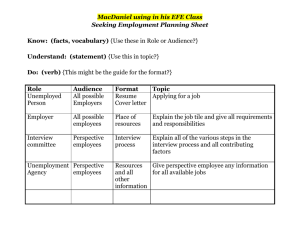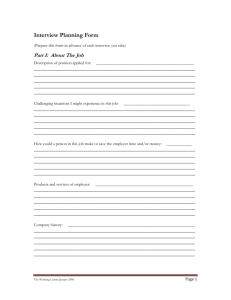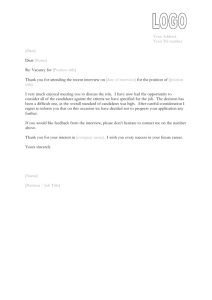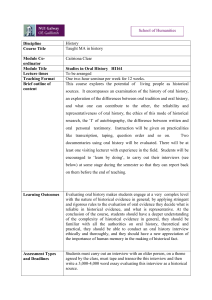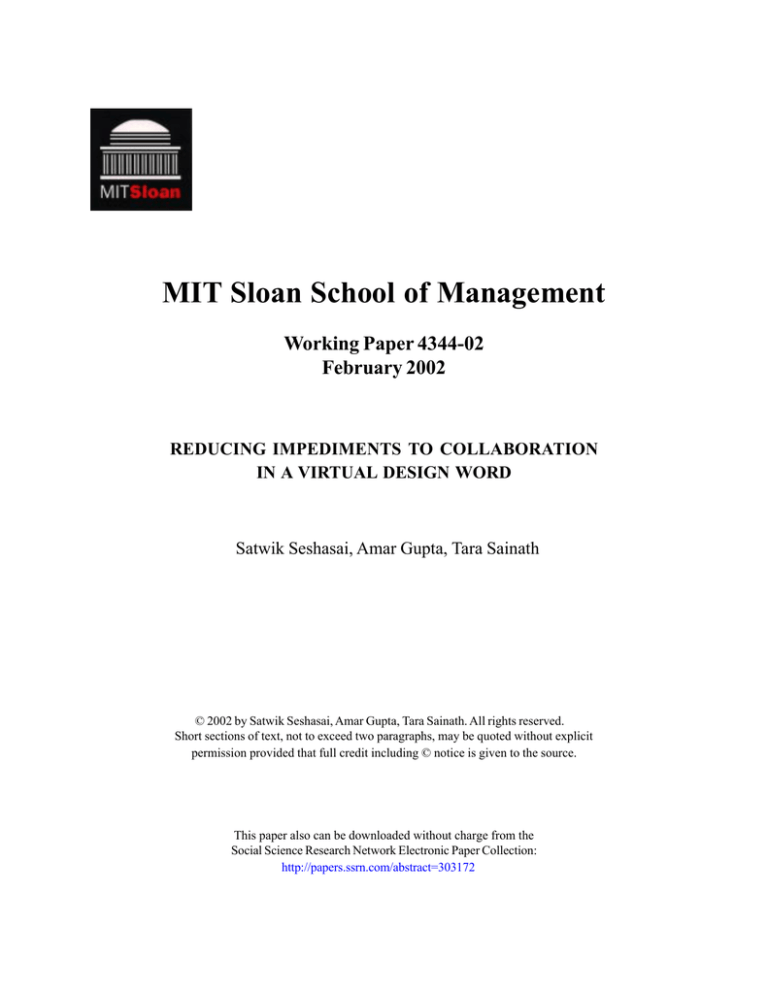
MIT Sloan School of Management
Working Paper 4344-02
February 2002
REDUCING IMPEDIMENTS TO COLLABORATION
IN A VIRTUAL DESIGN WORD
Satwik Seshasai, Amar Gupta, Tara Sainath
© 2002 by Satwik Seshasai, Amar Gupta, Tara Sainath. All rights reserved.
Short sections of text, not to exceed two paragraphs, may be quoted without explicit
permission provided that full credit including © notice is given to the source.
This paper also can be downloaded without charge from the
Social Science Research Network Electronic Paper Collection:
http://papers.ssrn.com/abstract=303172
REDUCING IMPEDIMENTS TO
COLLABORATION IN A VIRTUAL WORLD
Satwik Seshasai, Amar Gupta, Tara Sainath
Massachusetts Institute of Technology
77 Massachusetts Avenue, Rm E60-309
Cambridge, MA 02139
{satwik, agupta, tsainath}@mit.edu
Abstract
This paper presents a knowledge-based approach to
reducing impediments to collaboration in a
distributed environment. A major impediment to
such collaboration is the issue of communications clearly and efficiently expressing the desires of every
stakeholder in the process, as well as the major
decisions and the rationale behind these decisions.
The approach described in this paper, embodied in
the MATE system, provides a framework for making
these decisions in the engineering design process, by
eliciting and capturing the goals and desires of every
stakeholder in the design process through utility and
expense functions. The system uses a four faceted
knowledge-based approach of knowledge acquisition,
discovery, management and repository to focus on
various areas of functionality to be used in the design
process. The MATE approach will be combined with
the SSPARCy approach, also developed in this group,
to address crucial applications that are today
contingent on geographical proximity to occur with
equal or superior effectiveness in a virtual world.
While this paper analyzes a situation involving
engineering design, the proposed knowledge-based
approach is equally applicable to collaboration in
business, healthcare, government, and other
environments.
1. Introduction
Making decisions in the modern world, with multiple
teams and multiple stakeholders in various locations
presents many challenges. A major impediment to
such collaboration is the issue of communications clearly and efficiently expressing the desires of every
stakeholder in the process, as well as the major
decisions and the rationale behind these decisions.
Transferring relevant and useful knowledge from one
environment to another has the potential to provide
significant benefits to decision-makers dealing with
similar problems.
Emerging technologies have
provided the ability to make knowledge much more
available, but the vast amounts of knowledge
collected makes it even harder for people to decide
what knowledge is useful.
This paper discusses an effort to reduce this
impediment by providing a common interface for
members of the design process to collaborate, share
goals and desires, and overall rationale.
This
approach not only builds a knowledge repository, but
also facilitates knowledge discovery by immediately
presenting and processing data from all stages of the
design process. The immediate accessibility of
significant knowledge about the design process has
the potential to play a powerful role in an
increasingly distributed and virtual design world.
Although the specific case discussed here relates to
the design of space systems, the proposed approach
can be used to provide value to many other domains
where increased knowledge is required in the
decision making process.
This research is being conducted as part of the Space
Systems Policy and Architecture Consortium
(SSPARC) at MIT. The purpose of this group is to
examine space system design from a variety of
perspectives, and specifically, produce optimal
methods for choosing between various choices in
space system architectures. Current design methods
do not provide efficient means for rationally choosing
between a vast set of possible architectures. Simply
making an a priori choice of architecture and
designing the system around it allows optimization in
a local (e.g., spacecraft) sense, but not necessarily in
a global (e.g., architecture) sense1 . To move towards
making better higher-level decisions, it becomes
especially vital to capture and process as much
knowledge about the systems as possible.
2.
Multi-Attribute
Exploration (MATE)
Tradespace
The Multi-Attribute Tradespace Exploration (MATE)
system focuses on the issue of capturing and
processing the goals and the requirements of
stakeholders in the design process. It provides a
formalized means of exploring a tradespace by
incorporating preferences into decision criteria with
methods based in economic and operations research
theory 2 . This is done by using both utility and costbenefit analysis methods to obtain information from
all of the stakeholders in the geographically and
organizationally decentralized design process and
facilitate communication between them.
The
principle means of eliciting information is by
conducting a series of interviews with the
stakeholders to capture their preferences regarding
the various attributes of the design architecture.
These data are then used to drive the design process,
by providing information about the utility and cost of
each architecture being explored in the tradespace.
The interview process is central to the goals of the
MATE method.
2.1
Interview Tool
MATE and its follow-on Concurrent Design method
(MATE-CON) require a software platform to
facilitate the higher level of designer and customer
interaction.
The system supplements the
cumbersome face-to-face Multi-Attribute Utility
Analysis (MAUA) interview process previously
developed by the SSPARC team by using a Graphical
User Interface (GUI) and potentially web-based
computer interface with graphics that speed up the
utility interview process and provide a facility to help
document customer preference on a continuous basis.
The designer is able to describe attributes, ranges of
values, units and scenarios developed with input from
the customer. The system then prepares an interview
based on the attributes of the tradespace, and allows
the designer to conduct the interview and enter the
responses, as well as the customer to take the
interview independent of the utility facilitator. The
MATE interview process consists of multiple stages,
dealing first with single attribute utility parameters
and then with multiple attribute utility. Each stage
also contains a set of validation questions to ensure
that the variables being considered are independent of
each other. The structure for each of these interviews
is consistent, and the system facilitates each of these
stages.
The automated and customized interview sessions
will present the customer with a scenario using the
lottery equivalent probability (LEP) approach as
developed in the field of decision theory. Each
option is a situation with probabilities of two states
Figure 1: The attribute modification interface allows the designers and stakeholders to jointly decide which
attributes are most important in characterizing the system, and distill the relevant information about each attribute.
As the decision-making process concerning attribute definition is important, after each alteration of the attribute
parameters, the user is asked to document the rationale for the change, in order to provide useful knowledge for the
future.
for attribute analysis. The system continues in this
form until the customer answers that they are
indifferent to the two options. The software then
tallies the indifference points for later calculation and
moves on to analyze the next attribute. This process
can be conducted over time, and the results of each
interview can serve as the basis for developing
functions to assess the utility and the cost of design
based on the set of the attributes specified by the
customer or the set of customers. The integration of
these data with the design parameter data collected
by the SSPARCy system3 provides a comprehensive
assessment of the rationale at various levels of design
detail throughout the process.
3. The Knowledge Based Approach
The MATE approach described above achieves the
goal of facilitating the design process by using the
four faceted knowledge-based approach of
knowledge acquisition, discovery, management and
repository. This approach centers the project on the
fundamental notion that using knowledge within the
design process can be used to more effectively
achieve engineering goals by leveraging the
following facets on a concurrent basis 4 :
• Knowledge Acquisition is the process of capturing
information from various media, including people's
minds and handwritten documents, into computer
accessible media.
• Knowledge Management deals with mitigating
issues relating to heterogeneities in underlying
contexts of information coming from disparate
sources such as multiple stakeholders, multiple
projects and multiple stages of the process.
• Knowledge Discovery involves using emerging
techniques to analyze huge amounts of information
and to get better insights into such information than is
possible using the best human domain experts.
• Knowledge Dissemination is the automated
extraction of the most relevant pieces of information
from a huge computer based information
infrastructure with such extraction being tailored to
the needs of different constituencies of users in an
organization.
Figure 2: The interview interface acts as the primary source for knowledge acquisition, automatically generates
interview questions, and provides real-time feedback to make the interview session more rational and interesting.
This four-faceted technique allows efficient exchange
of knowledge vital to collaboration.
In the
succeeding subsections, we demonstrate how each of
these four building blocks has driven the design of
these tools.
3.1 Knowledge Acquisition
By conducting the interview with a software tool, the
process can be made much quicker, and tailored to
the individual responses.
Calculations can be
performed while the interview session is proceeding.
Designers are provided with the options for adding
and modifying attributes, and also for changing the
scenario used to describe an attribute to the customer.
As an improved communication interface is the core
goal of this endeavor, the system allows not only the
designer, but also the customer to provide feedback
about the structure of the interview process. The
choices made in structuring the interview are
interesting independent of the results of the
interview. This tool can also capture the choices
made during the interview process, and use such
information to provide knowledge about the design of
the system as well as the design of the interview
itself. The latter allows for future interviews to be
conducted in a more efficient manner. The major
issue raised in this area is how much control and
flexibility is appropriate in customization of the
interview session in real-time. Allowing excessive
variability in the interview process may reduce the
reliability and consistency of the results.
3.2 Knowledge Management
In this concept demonstration prototype endeavor, we
have emphasized the visualization aspect. The
paradigm of customized visualization alone adds
value to customers by helping them understand the
way in which their utility estimates evolve over time.
The multi-attribute cost and utility functions can be
created in graphical format. One can graphically
witness how answers during the interview process
impact the design process. This impacts the integrity
of the interview process in both positive and negative
ways - a very important design issue that needs
additional exploration. The positive value-added is
that with increased real-time knowledge, the
customer may make more rational decisions: when
faced with a graph which plots each of their answers
for a given attribute, a customer may be alerted to
reconsider the answer. On the negative side, the
customer may tend to give conventional and risk
averse responses, as most customers probably prefer
to give answers which appear to be consistent and
rational. Further, a customer's true preferences may
b e changing over time, and it might be harmful to
allow the customer to "game" the system. This is
another issue which can be explored with the
introduction of an interactive tool to facilitate the
interview. The optimal level of customization will
depend on the characteristics of the particular
problem domain.
Untility of Spatial Resolution
1.2
Although the prototype system is implemented in
Microsoft Excel for a variety of reasons, this system
is designed to be generic and not be limited by the
specific implementation described here. One of the
major hurdles faced by the SSPARC team in
implementing this process was educating the
stakeholders and helping them to think in terms of the
attribute system5 .
Excel provides an interface
familiar to most customers. For ease of the customer
and designer, Excel provides pre-existing GUI
functionality in addition to familiar data analysis
tools, especially for presenting data in graphical and
other visual formats. This allowed the team to focus
primarily on developing additional functionality for
the system. While the robustness of the Excel
environment is less than the desired level, we opted
for the use of a commonly used software interface
since it reduces the time and effort needed to transfer
data across platforms.
1
0.8
0.6
0.4
0.2
0
0
20
40
60
Resolution (degree X degree)
Figure 3: Customers can view utility over time.
4.3 Knowledge Discovery
One of the major intellectual questions that MATE
attempts to address is the role of utility and attribute
based design to design rationale. The SSPARCy
system, developed in 2001, solicits design rationale
in a somewhat ambiguous manner, by asking the
designer to manually describe major design decisions
in a textual format.
Collecting data from the
customer, and monitoring the designer's choices in
creating the utility functions provides the SSPARCy
system with a numerical form for design rationale.
The two systems, SSPARCy and MATE, have a
common interest in collecting design parameters over
time, and reacting to the major trends and changes.
By using one integrated system to collect both forms
of data, one possibility is to relate each moment of
the design process to a specific interview, thereby
associating an interview with each value of a design
parameter. Major changes in the design parameters
can then be easily mapped against the changing
preferences elicited during the interviews. Such
integration provides better information to both
efforts, by relating the utility functions directly to any
state of the design, as well as providing the
motivation for major design decisions in a numerical
format.
4.4 Knowledge Dissemination
The MATE system also contains a set of analysis
tools to process the data collected from the interviews
and the SSPARCy design parameter capture process.
First, a set of reports can be produced to document
both the customer's preferences and the various
stages of the design process, as well as perhaps the
design rationale specified by the designer. The use of
an integrated tool allows for a consistent template to
be used and for easy manipulation of the sets of data
being reported.
A comprehensive knowledge
repository will evolve over time. When a new person
joins the team, such a knowledge repository provides
an invaluable mechanism for transferring the
knowledge about the design process to the new
member.
In addition to the reports, algorithms for utility and
expense function generation are being integrated with
the system to produce meaningful and useful tools
with the interview results. The results of the
interviews will be used to design a specific function
for each stakeholder at the end of each interview.
This will allow all iterations of an architecture to be
assessed, and the changing utility of an architecture
to be related to the changing preferences of the
customer. The algorithms for developing these
functions have already been delineated by the
SSPARC team.
Finally, other data mining tools will be implemented
to use the knowledge repository as a vehicle for
knowledge discovery within the design process.
Once adequate data have been collected about a
specific design process, or multiple design processes,
interpreting the patterns within these data can lead to
better decisions in future endeavors.
5. Future Directions
With the base functionality developed in each
approach, the next step is to incorporate "intelligent"
functionality to process the knowledge captured by
each approach. The ultimate goal is to combine
approaches into a single, powerful framework for
knowledge-based engineering design.
A major motivation for pursuing this goal is the
gradual implementation of data mining technology to
use knowledge effectively.
One of the major
knowledge discovery efforts will be to analyze data
from mu ltiple design projects, to gain better insights
into how the ultimate design is related to the set of
spatially and temporally distributed inputs from the
stakeholders. This would help to formulate the
strategy for having the system provide “automated”
baseline designs that might best satisfy a
stakeholder's preferences based on past projects and
past successes and failures. One aspect of this
capability is to manage data over multiple stages
throughout the design process. As requirements and
situations change throughout the design process, it is
important to capture the changing goals and desires
of the stakeholders, and examine these data to
discover trends in how these changes happen and
how the project is affected by these changes.
Another issue to be addressed by data mining
techniques is to compare the preferences of similar
stakeholders. Relationships between the various
roles in the design process will be better explained
through the preference data, and future projects will
benefit from knowing how previous members in the
same role operated under similar conditions.
Another issue for employing these approaches in a
virtual design world is the need for multimedia forms
of input to ease communications over geographic
boundaries. A text -to-speech engine in the interview
system would make the interview process easier for
those not familiar with the computer interface, as
well as provide a human voice to a discussion which
is usually carried out with humans. The other
component of this is voice recognition - once again,
this allows the users to communicate with the system
in a much more human manner. The functionality
has already been developed to allow users from
multiple locations to view the status of an interview
in real-time. By integrating real-time communication
aspects such as chat sessions, audio and video
conferencing, the interview session could involve a
large number of locations. It would then be feasible
to involve more stakeholders in the process, because
the need for geographical proximity is reduced.
Finally, the above approach will be tested in an
upcoming graduate level space system design course
at MIT, and the feedback from that course will be
used to further enhance the overall approach and
architecture.
6. Related Work
Among the projects that attempt to aid the process of
transferring customer goals and desires to developing
the actual design parameters, two deserve mention
here. One system, under development at the ChungHua University in Taiwan6 , uses a rule-based
algorithm for transferring customer needs directly
into specifications, by developing a matrix of weights
between attributes and design factors. The weights
are then used to determine rules, or relations,
indicating how certain design parameters should
change value based on other parameter values. The
MATE system builds on this approach by involving
the goals and desires of multiple stakeholders, as well
as using the evolving knowledge repository to
facilitate decisions on how specifications can be
derived from customer preferences.
Another approach, the Artificial Intelligence
supposed Design of Aircraft (AIDA) project7 , is a
step closer to the direction of MATE. It applies a
case-based reasoning method which suggests initial
values for an aircraft lay-out using knowledge from
previous cases. Once again, however, the AIDA
approach is dealing with the goals and desires of only
one stakeholder. Additionally, it seeks to find the
optimal architecture, rather than to provide a
knowledge-based framework for the designer to
explore the various options.
7. Conclusion
One of the major impediments to collaboration in a
virtual design world is effective communications that
can transcend spatial and temporal barriers. The two
complimentary approaches described ni this paper,
SSPARCy and MATE, capture the essential parts of
the communication process that typically depends on
geographical proximity. By capturing these parts in
the four-faceted knowledge-based framework
described above, and extracting value through
intelligent processing of this knowledge, one can
allow knowledge to be shared effectively across
geographic, organizational, and temporal boundaries.
8. Acknowledgements
This work would not have been possible without the
support of the entire team at the Space Systems,
Policy and Architecture Research Consortium.
Professors Daniel Hastings, Hugh McManus and
Joyce Warmkessel have provided valuable guidance
and feedback. Adam Ross and Nathan Diller were
the principle developers of the MATE interview
process, and provided the motivation for developing
a software system to implement this approach.
Quincy Scott, Shane Cruz and Presley Canady
assisted in developing the software for the SSPARCy
approach.
Winston Chang, Anna Konfisakhar,
Carolyn Ng, and Connie Tao worked with the authors
to develop the software and research related works
for the MATE approach.
9. References
1
McManus, Hugh and J. Warmkessel. "Creating
Advanced Architectures for Space Systems: Product
and Process", August 2001.
2
Ross, Adam. MATE: Defining Roles, Stakes, and
Decision Makers. Presentation to SSPARC group,
November 20, 2001
3
Gupta, Amar, Satwiksai Seshasai, and Jason Yeung.
"Automated Design Rationale Capture."
SMS
Virtual Worlds Conference proceedings, San
Antonio, Spring 2002.
4
Gupta, Amar. "A Four-Faceted Knowledge-Based
Approach for Surmounting Borders", Journal of
Knowledge Management, Vol. 5, No. 4, December
2001.
5
Diller, Nathan, et. al. "B-TOS: Terrestrial Observer
Swarm." Final Report, 16.89 Space Systems
Engineering, MIT. Spring 2001.
6
Chiu-Chi Wei, Ping-Hung Liu and Chie-Bein Chen,
"An automated system for product specification and
design". Assembly Automation: Volume 20: Number
3, 2000 pp 225-232. MCB University Press.
7
Delft
University
of
Technology
:
http://www.kbs.twi.tudelft.nl/Research/Projects/AID
A/

